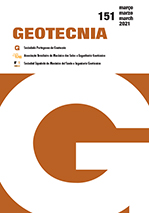Anchor bond length design through the analysis of acceptance tests
DOI:
https://doi.org/10.24849/j.geot.2021.151.06Keywords:
Bond length, Van der Veen extrapolation, load capacity, anchor coefficientAbstract
The technique in re-injectable and pre-stressed anchors is widely used with retaining structures in Brazil, but there is still much to be studied about the determination of the load capacity and anchor bond length design. For the development of this study it was considered a database of the 40 anchors used in an anchored wall located in João Monlevade. Through the acceptance tests analysis the Van der Veen (1953) extrapolation was applied, thus obtaining estimations of the load capacity to of all the anchors performed in the anchored wall. Considering the restriction proposed by Aoki (2013), the reliable anchored lengths of each the anchors was estimated through the load capacity equation proposed by Porto (2015) and compared with the design anchored lengths. The results were satisfactory, since the anchored lengths estimated from extrapolation were smaller than the design anchored length, thus obtaining relatively a more economical design. In addition, this study proposed a value for the “anchor coefficient” of the sandy clayey silt soil found at the construction site of the anchored wall, showing the relevance of this parameter for the estimation of the load capacity of anchors in the type of soil.
Downloads
References
ABNT (2006). NBR 5629 – Execução de tirantes ancorados no terreno. Associação Brasileira de Normas Técnicas, Rio de Janeiro.
ABNT (2018). NBR 5629 – Tirantes ancorados no terreno – Projeto e execução. Associação Brasileira de Normas Técnicas, Rio de Janeiro.
Aoki, N; Cintra, J. C. A; Tsuha, C. H. C; Giacheti, H. L. (2013). Fundações, ensaios estáticos e dinâmicos. Oficina de Textos, São Paulo, Brasil.
Bustamante, M.; Doix, B. (1985). Une méthode pour le calcul des tirants et des micropieux injectés. Bulletin de liaison des laboratoires des ponts et chaussées, n. 140, p. 75-92.
Décourt, L.; Quaresma, A.R. (1978). Capacidade de Carga de estacas a partir de Valores de SPT, 6º Congresso Brasileiro de Mecânica dos Solos e Engenharia de Fundações, Rio de Janeiro, anuais, v. 1.
Kishida, H. (1967). Ultimate bearing capacity of piles driven into loose sand. Soil and Foundations, vol. 7, no.3 p.20-29
Mendes, F. B. (2010). O uso de ferramenta computacional na avaliação e dimensionamento de cortina atirantada. Dissertação (Mestrado em Geotecnia). Escola de Minas, Universidade Federal de Ouro Preto, Ouro Preto, 148p.
More, J. Z. P. (2003). Análise numérica do comportamento de cortinas atirantadas em solos. Dissertação (Mestrado em Engenharia Civil). Pontifícia Universidade Católica, Rio de Janeiro, 120 p.
Porto, T. B. (2015). Comportamento geotécnico e metodologia via web para previsão e controle. Tese (Doutorado em Geotecnia). Núcleo de Geotecnia, Universidade Federal de Ouro Preto, Ouro Preto, 482p.
Phoon, K. K.; Kulhawy, F. H. (2008). Serviceability-limit state reliability-based design. In: Phoon, K. K. (ed.) Reliability-Based Design in Geotechnical Engineering: Computations and Applications. London.
Souza, R. N. (2001). Ancoragens reinjetáveis e protendidas em solo: previsão de comportamento e controle de execução. Tese (Doutorado em Engenharia Civil). Escola Politécnica, Universidade de São Paulo, São Paulo.
Van der Veen, C. (1953). The bearing capacity of a pile. In: International Conference on Soil Mechanics and Foundation Engineering, Proceedings vol. 2, p. 84-90, Zurich.
Vasconcelos, L.A.C. (2016). Estudo da capacidade de carga de ancoragens protendidas e reinjetáveis em maciços geotécnicos. Dissertação (Mestrado em Geotecnia). Núcleo de Geotecnia, Universidade Federal de Ouro Preto, Ouro Preto, 112p.




